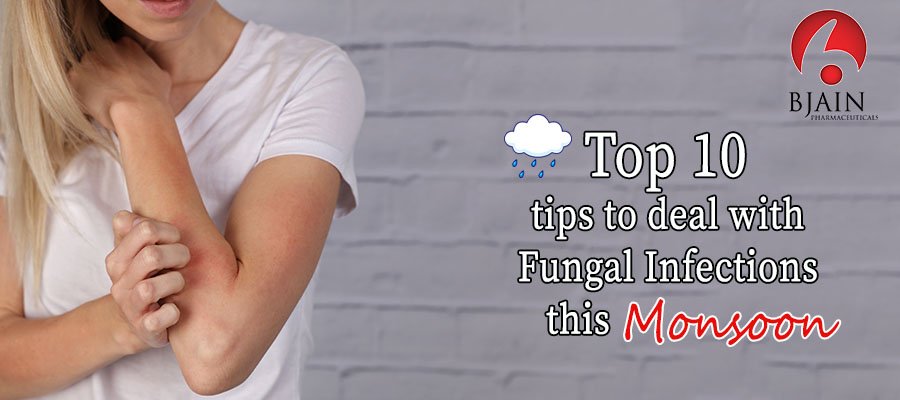Whereas the rainy season provides a desperately needed break from the intense heat, it also presents unique challenges, particularly about skin health. Throughout the monsoon season, fungal diseases are the most prevalent problems. The moist and elevated humidity levels provide an ideal environment for the growth of fungus, which can cause infections affecting the skin, nails, as well as lungs.
5 commonest fungal infections during the rainy season
Usually, blisters, edema, pigmentation, and red, itchy patches are the symptoms of fungal skin diseases.
- Athlete’s Foot:
A fungal illness commonly referred to as “athlete’s foot” mostly impacts the skin within your toes. Since it prefers warm, humid conditions, rainy weather is ideal for its arrival. Burns, cracks, and itching are typical symptoms. Keep your feet clean and dry to prevent athlete’s foot. After being wet, be certain that you clean and completely dry your feet. To prevent moisture retention, wear ventilated shoes and change your socks often.
2. Ringworm:
An infectious fungal disease, ringworm manifests as red, round, and itchy eruptions on different body areas. It can spread via physical contact with a human or animal who has been impacted, as well as by exposure to contaminated surfaces. Wash your hands frequently, refrain from sharing personal objects, and practice proper sanitation to avoid ringworm. Since fungus likes moist conditions, keep the surrounding areas dry and clean.
3. Fungal Nail Infections:
The hallmarks of fungal nail infections include brittle, discolored, and thick nails. They frequently develop due to extended contact with moisture, which makes the monsoon season an ideal period for their formation. Steer clear of extended periods of exposure to moisture and ensure that your hands and feet are completely dry after handling water. To encourage airflow, wear shoes with open toes wherever feasible.
4. Candidiasis:
Yeast infections, or candidiasis, may impact many regions of one’s body, such as the vaginal area and mouth (oral thrush). Maintain good hygiene, particularly around sensitive areas, to ward against candidiasis. To boost the natural defenses of your body, put on loose-fitting, airy clothing, stay away from fragrant items around your genital area, and eat a well-rounded diet.
5. Aspergillosis:
Aspergillosis is a fungal illness of the respiratory system brought on by breathing Aspergillus spores in the air. Various typical symptoms include wheezes, coughs, and trouble with breathing. Steer clear of high-mold concentration places, such as wet basements and poorly ventilated areas, to lower your chance of developing aspergillosis. Maintain the quality of the air inside your home by using dehumidifiers and air purifiers. When it rains a lot, keep your house closed to keep spores out of your house.
General symptoms of the fungal infections
Depending on the fungus causing the disease and the location of the infection, fungal skin infections might manifest differently. Some of the typical symptoms include:
- Skin rashes that have elevated or uneven margins
- Blisters and redness
- Pain, Sensations of burning, biting, or itching
- Skin that peels
- Cracking
- Pain in the affected area of the body (scalp, ear, foot, nail, etc.)
- Splitting and loss of diseased hair;
- Occasionally; discoloration of crumbly, brittle finger and toenail.
These are some strategies to fight against fungal diseases during the monsoon season.
- Maintain dryness
This is most likely the most crucial element in avoiding fungal infections. One of the main things that encourages fungal development is moisture. Many people turn to coconut oil as their all-natural remedy for fungus-related diseases. This is untrue because using coconut oil just fosters the growth of fungi!
On the contrary, the region has to be kept completely dry to prevent fungal infections. After taking a bath, be careful to completely dry yourself, especially around the groin, underarms, and the spaces between your toes- areas that are prone to moisture retention. Before putting on clothes, make sure these regions are totally dry using a gentle towel.
2. Dress in breathable clothing
Wear loose, airy clothes made of environment-friendly natural materials that help with humidity and heat well, and fostering of the growth of fungi. To prevent fungal infections, it’s also critical to change out of moist items as soon as possible.
3. Select appropriate footwear
Your feet are frequently exposed to damp environments during the rainy season, which increases the risk of fungal illnesses like athlete’s foot. Put on sandals or open-toed shoes to let your toes relax. Refrain from standing around in damp shoes and socks for long. Steer clear of really tight shoes. Before wearing your shoes again, make sure they are totally dry if they become wet.
4. Maintain Good Hygiene
A daily bath and good hygiene practices are essential for avoiding fungal infections. Use antifungal soaps or body wash if you are prone to infections or sweat a lot. Use an anti-dandruff shampoo if you are experiencing itching and flaking scalp. Ensure that your living spaces, especially bathrooms are kept clean and dry.
5. Stay Hydrated and eat a balanced diet
Fungal infections can be warded off with the aid of an effective immune system. Drink lots of water and eat a well-balanced, vitamin- and mineral-rich diet to stay hydrated. Food with natural antifungal properties, such as garlic and yoghurt can also be included in your diet.
6. Hygiene Practices
Steer clear of sharing personal goods with other people, such as combs, razors, socks, shoes, and towels. Ensure that items like bedsheets and clothes are washed regularly with hot water and kept clean.
7. Keep your living environment dry
To lower the humidity levels indoors, use air conditioners or dehumidifiers. Make sure your house has enough ventilation, particularly in the kitchen and bathroom areas. Resolve any leaks or wet areas instantly to stop the growth of fungi. Around the monsoon season, fungal infections may be a nuisance, but you can avoid them with these easy techniques and methods. By practicing proper hygiene, staying dry, and taking precautions, you can relish the rainy season instead of worrying about becoming sick.
Homeopathic medicines for fungal infections
A beneficial and efficient kind of treatment is provided by homeopathy, which enhances the body’s natural ability to fight and get rid of fungal infections. Natural homeopathic treatments, in contrast to conventional therapy, aim to identify and cure the root causes of fungal diseases rather than masking them. Because the homeopathic remedy eliminates the infection’s fundamental causes, it offers a long-lasting remedy.
Athlete’s foot
“Athlete’s foot” is the term for a fungal disease of the feet. Typically, it causes irritation, burning, and inflammation, especially along the outer edges of the foot and inside the space that separates the toes. Normally, the fungus thrives in warm, moist areas like swimming pools, socks, and shoes. Petroleum and Silicea are the best homeopathic remedies for fungal infections of the feet (athlete’s foot).
Nail Fungal Infection
Graphites and Antimonium crudum are the most effective homeopathic remedies for tinea unguium, a fungal disease of the nails. The most effective homeopathic treatment for stained and crooked nails is antimonium crudum. The sensitivity of the flesh under the nails is excruciating. Graphites are a beneficial homeopathic remedy for fungal infections that cause thick, severely painful, and crippled nails.
Tinea capitis
Patches on your head are the consequence of a fungal infection. The condition is more prevalent among younger people. Patches of itching and scaly skin occur on the scalp. Thrush, also known as candidiasis, is an additional typical fungal condition. It generally impacts the vagina, lips, and epidermis. Thuja and Kali sulphuricum are the finest effective homeopathic remedies for tinea capitis, a fungal disease that affects the scalp.
Tinea corporis
Thuja, Tellurium, and Sepia are the best homeopathic remedies for fungal infections of your skin (tinea corporis). Since each patient is unique, never self-medicate. See your homeopathic physician to determine which medication is best for you.
Omeo Anti-fungal Drops from BJain Pharmaceuticals is a special formulation that helps alleviate all the complaints of fungal infections. It helps relieve itching, redness, swelling, and scaly skin that arises from fungal infection. It is effective in cases of ringworm, jock itch, athlete’s foot, and yeast infection, etc.
Conclusion:
Homeopathy is a perfect solution for all your problems including fungal infections. It treats you holistically, removes the underlying disorder, and balances your health. Its gentle, effective nature makes homeopathy a desired choice of treatment.

Dr Aditi
Dr Aditi (BHMS) from NHMC Delhi, HMO ( Chandigarh Administration), Ex- SRF ( CCRH ), currently doing a research study of effect of Homoeopathic medicines in Mother and Child Health care in Chandigarh.


